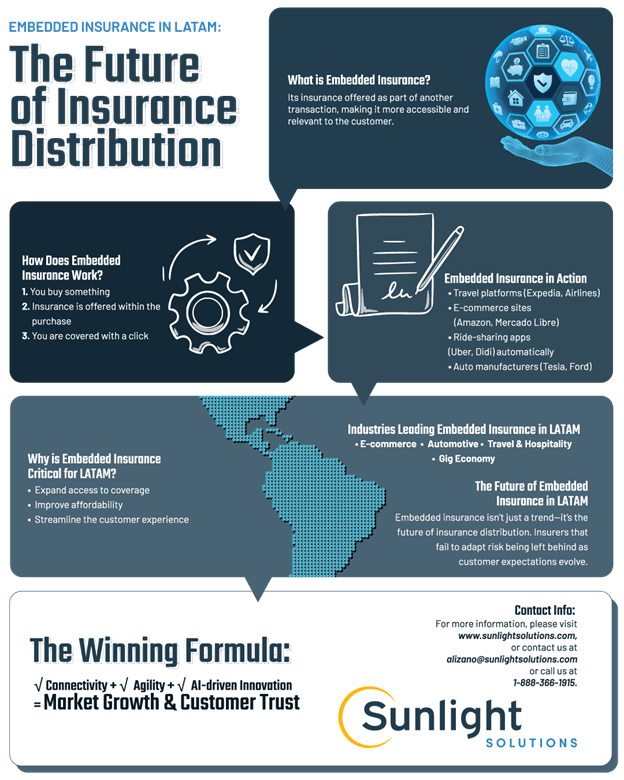Contenido
- 1 The Future of Embedded Insurance in Latin America: Opportunities and Challenges
- 2 Financial Inclusion and Trust in Digital Services
- 3 Future Outlook: What’s Next for Embedded Insurance in LATAM?
- 4 What is Embedded Insurance?
- 5 Market Potential in Latin America
- 6 Key Benefits of Embedded Insurance
- 7 Challenges and Barriers to Adoption
- 8 The Role of Technology in Embedded Insurance
- 9 Global Insights and Case Studies
- 10 Conclusion
- 11 Call to Action
- 12 Estructura y dirección restablecida de Chubb en América Latina
- 13 Los 4 cambios que están revolucionando el seguro de vehículos
- 14 ¿En dónde invierten las empresas de América Latina?
- 15 Empresas chilenas podrán utilizar firma digital válida en 4 países de Latinoamérica
The Future of Embedded Insurance in Latin America: Opportunities and Challenges
The insurance industry in Latin America is undergoing a significant transformation, driven by the rapid adoption of embedded insurance solutions. Embedded insurance integrates coverage seamlessly into everyday transactions, offering consumers immediate and relevant protection without the need for separate purchasing processes. This innovation is reshaping insurance distribution, enhancing accessibility, and opening new revenue streams for insurers and businesses alike.
Financial Inclusion and Trust in Digital Services
With nearly 50% of Latin America’s population unbanked or underbanked, traditional insurance models often fail to reach a large portion of consumers. However, embedded insurance can leverage fintech partnerships to provide coverage through digital wallets, neobanks, and mobile applications, making insurance more accessible to underserved communities.
While digital transactions are growing, many Latin American consumers remain skeptical of online insurance offerings. Building trust through transparent policies, clear communication, and easy claims processes is critical to driving adoption.
Future Outlook: What’s Next for Embedded Insurance in LATAM?
Expansion into Underserved Markets
Embedded insurance has the potential to reach rural and low-income communities through mobile and fintech solutions, addressing gaps in traditional insurance models.
Growth of On-Demand and Parametric Insurance
Innovations like parametric insurance—where payouts are triggered by predefined events (e.g., earthquakes, hurricanes)—can provide faster, more reliable coverage for Latin America’s climate-vulnerable regions.
Collaboration Between Insurers and Digital Platforms
As digital ecosystems continue to grow, strategic partnerships between insurers, fintechs, and e-commerce giants will drive further adoption of embedded insurance across industries.
Latin America presents a unique market for embedded insurance due to its growing digital economy, increasing smartphone penetration, and a large uninsured population. This white paper explores the landscape, benefits, challenges, and future potential of embedded insurance in the region, backed by global insights and data.
What is Embedded Insurance?
Embedded insurance refers to the integration of insurance products within a broader purchase experience. Instead of requiring customers to seek out standalone policies, coverage is offered at the point of sale, making it a natural extension of the purchasing process.
How It Works
- Consumer makes a purchase – Buying a flight ticket, renting a car, or purchasing an electronic device.
- Insurance is offered in real-time – Travel insurance, extended warranties, or accident coverage appear as an option.
- Instant coverage with minimal effort – With a simple click, the consumer is insured without additional applications or paperwork.
Examples of Embedded Insurance in Action
- Travel platforms (e.g., Expedia, LATAM Airlines) offer trip cancellation insurance.
- E-commerce giants (e.g., Amazon, Mercado Libre) provide extended warranties for electronic purchases.
- Ride-sharing apps (e.g., Uber, Didi) automatically include accident coverage for drivers and passengers.
- Auto manufacturers (e.g., Tesla, Ford) bundle insurance with vehicle purchases, simplifying the ownership experience.
Market Potential in Latin America
Low Insurance Penetration
Despite its population of over 660 million, Latin America has one of the lowest insurance penetration rates globally. According to Swiss Re, insurance penetration in the region remains below 3% of GDP, compared to 7% in the U.S. and over 10% in Europe. Embedded insurance provides an opportunity to bridge this gap by integrating coverage directly into consumer transactions.
Digital Transformation Driving Growth
The expansion of fintech and e-commerce platforms is accelerating the adoption of embedded insurance. According to Statista, e-commerce sales in Latin America reached $85 billion in 2021 and are expected to surpass $160 billion by 2025. As digital transactions grow, so does the opportunity for embedded insurance to become a standard feature in consumer purchases.
Key Benefits of Embedded Insurance
For Consumers
- Convenience – Seamless integration eliminates the need for separate applications or interactions with insurance agents.
- Affordability – Smaller, targeted policies (e.g., microinsurance) make coverage accessible to lower-income segments.
- Relevance – Insurance is offered exactly when and where it’s needed.
For Insurers
- Expanded Customer Base – Access to previously uninsured demographics.
- Improved Underwriting Efficiency – AI-driven pricing models optimize risk assessment.
- Higher Conversion Rates – Simplified processes reduce drop-offs compared to traditional policy applications.
For Businesses
- New Revenue Streams – Companies can earn commissions or enhance customer loyalty through embedded insurance offerings.
- Enhanced Customer Experience – Providing built-in protection increases consumer confidence and satisfaction.
- Competitive Differentiation – Offering seamless protection can differentiate a business from competitors.
Challenges and Barriers to Adoption
Regulatory Complexity
Latin America consists of diverse regulatory environments, making cross-border insurance offerings challenging. Countries such as Brazil, Mexico, and Argentina have different requirements for underwriting, licensing, and claims handling. Companies must navigate these complexities to ensure compliance.
Legacy Systems in Insurance
Many insurers in Latin America still rely on outdated IT infrastructure, which hinders their ability to integrate with modern digital platforms. Transitioning to API-first and cloud-based insurance management systems is essential for success.
Consumer Awareness and Trust
The Role of Technology in Embedded Insurance
AI-Powered Underwriting and Pricing
Artificial intelligence (AI) is transforming insurance by enabling dynamic pricing and real-time risk assessment. AI-driven models analyze large datasets to personalize policies, ensuring fair pricing and improved customer engagement.
API-Driven Ecosystems
To integrate seamlessly with e-commerce, banking, and mobility platforms, insurers must adopt robust API frameworks. API-driven solutions allow for flexible, real-time communication between insurers and distribution partners.
Real-Time Claims Processing
Traditional claims processing can take weeks, leading to customer frustration. With automation and AI, insurers can process claims instantly, reducing fraud and enhancing customer satisfaction.
Global Insights and Case Studies
China’s Embedded Insurance Boom
China has been a pioneer in embedded insurance, with companies like Ping An and ZhongAn leveraging AI and big data to offer instant, microinsurance policies. In 2020 alone, ZhongAn sold over 8 billion policies through embedded distribution models.
Europe’s Digital-First Approach
In Europe, companies like Allianz and AXA have partnered with digital platforms to embed insurance into mobility services, e-commerce, and banking applications. The European Insurance and Occupational Pensions Authority (EIOPA) supports embedded models that enhance financial inclusion.
Latin America’s Emerging Success Stories
- Brazil: Insurtechs like Justos use AI-based risk models to offer personalized car insurance directly integrated into vehicle financing.
- Mexico: BBVA partners with embedded insurance providers to offer life and health insurance through its mobile banking app.
- Colombia: Digital banks like Nubank include embedded insurance as part of their credit card offerings.
Conclusion
Embedded insurance is poised to transform the Latin American insurance landscape by making coverage more accessible, relevant, and seamlessly integrated into everyday transactions. While challenges remain—particularly in regulatory compliance and legacy system integration—the potential benefits for consumers, insurers, and businesses are significant. As technology advances and digital adoption increases, embedded insurance will play a crucial role in shaping the future of financial protection in Latin America.
Call to Action
To capitalize on this opportunity, insurers must invest in API-driven platforms, AI-powered underwriting, and strategic partnerships with digital service providers. Companies that embrace innovation and adaptability will lead the next wave of growth in the Latin American insurance market.







